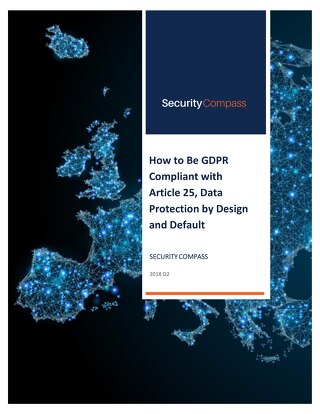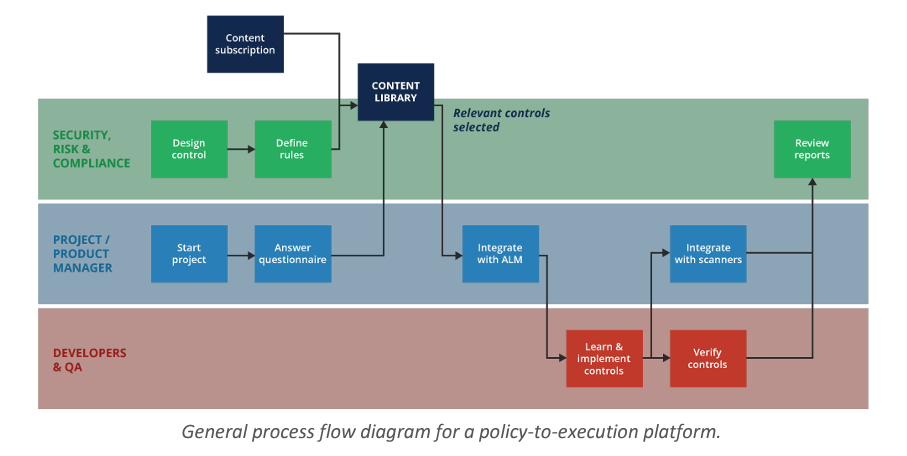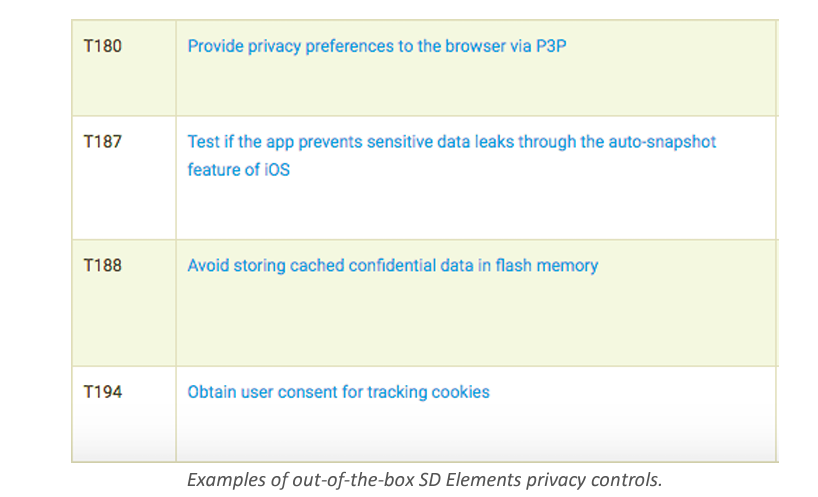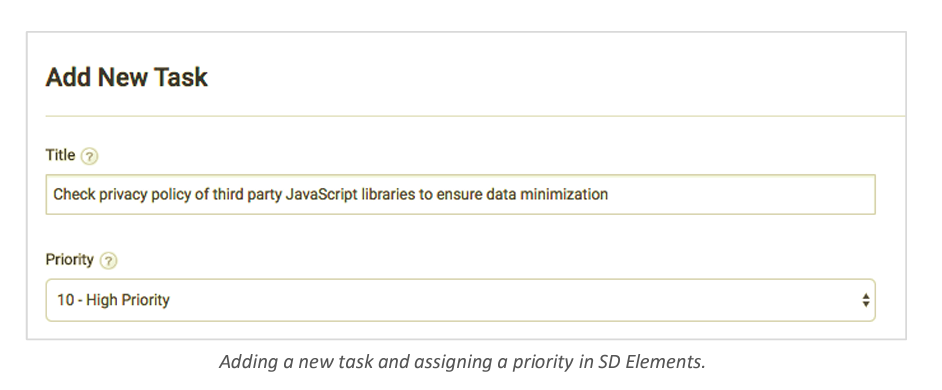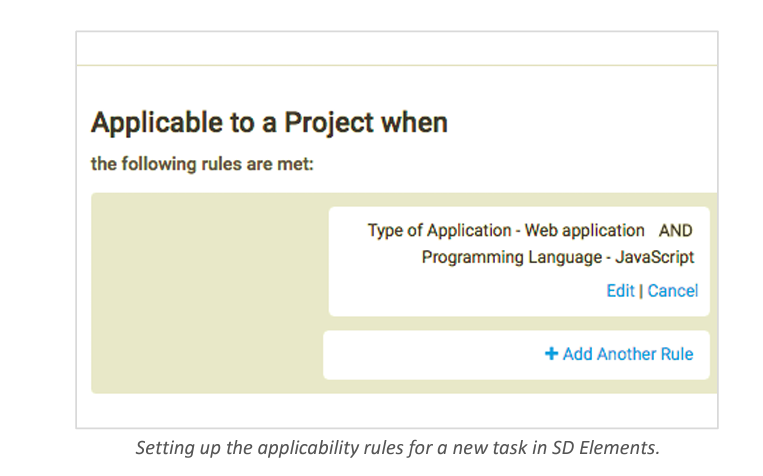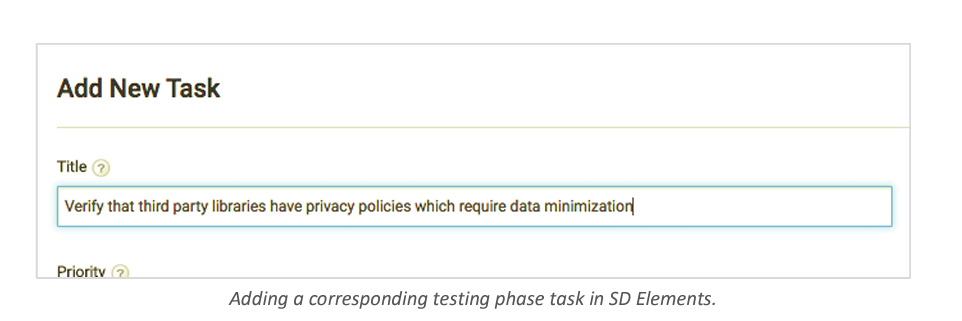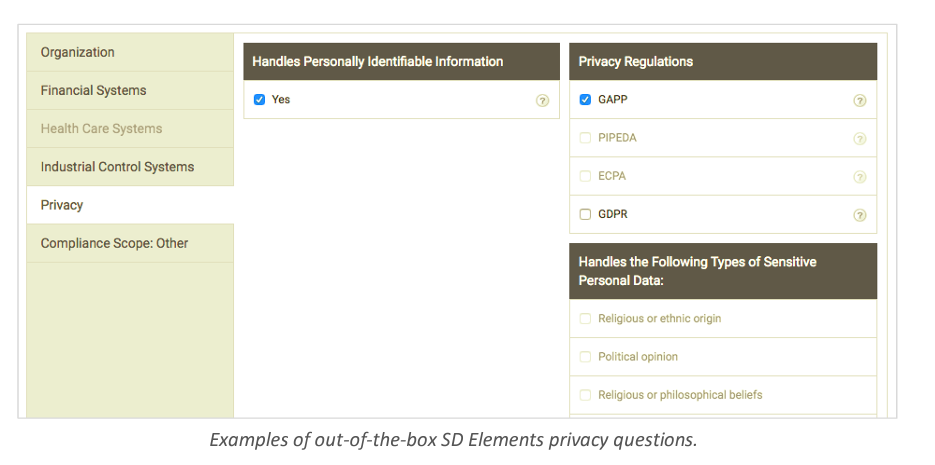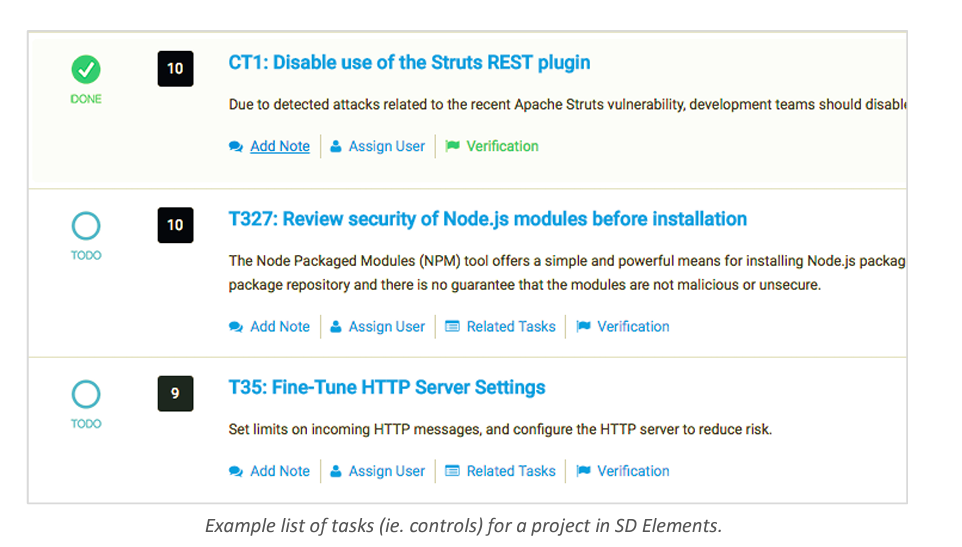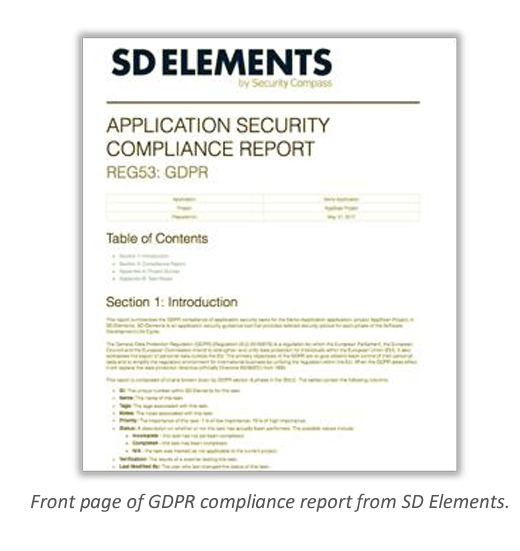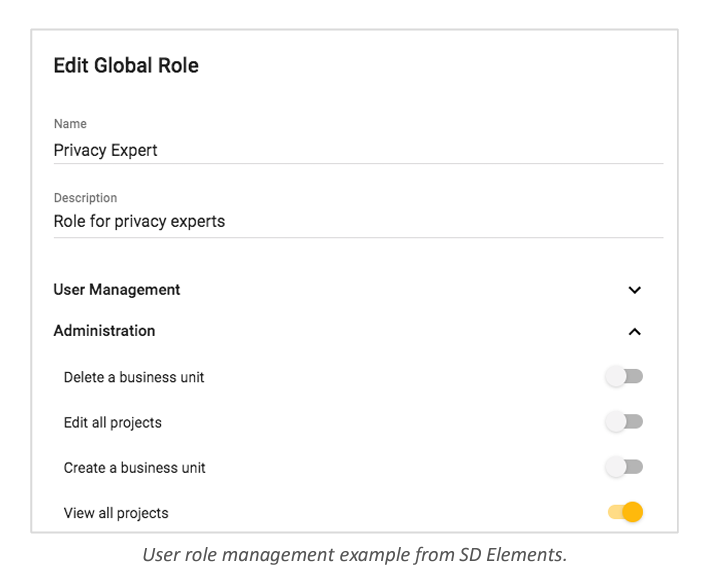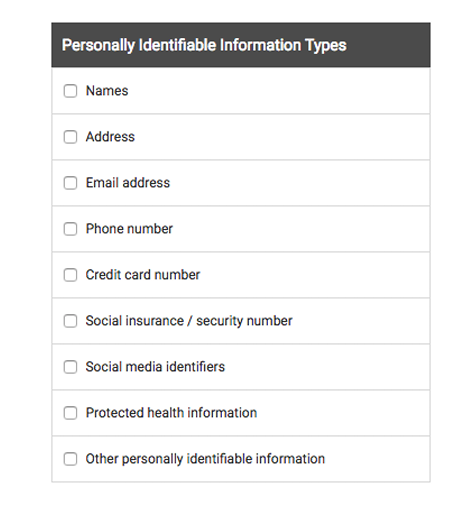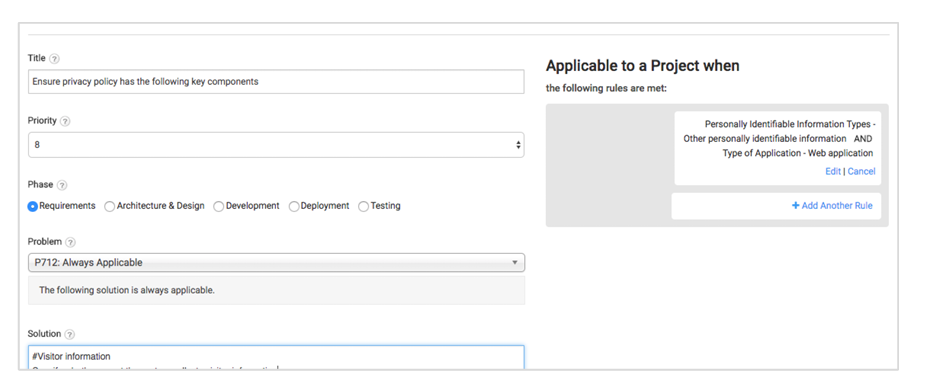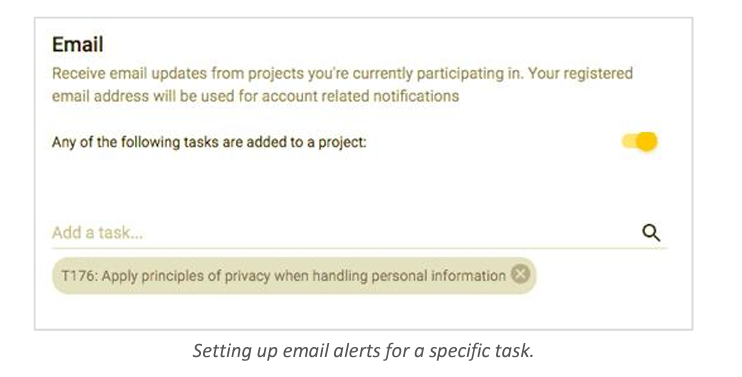BACKGROUND
The European Union introduced the General Data Protection Regulation (GDPR) to improve the security of its residents. Going into effect on May 25, 2018, GDPR will impose steep penalties on organizations that fail to comply with its measures and has forced organizations around the world to increase their focus on privacy and security.
Several articles in GDPR affect software development, but one in particular will prove especially challenging for organizations falling under the new regulation: Article 25, “Data Protection by Design and Default.” This means the following:
By Design: “The controller shall…implement appropriate technical and organizational measures…which are designed to implement data protection principles…in an effective manner and to integrate the necessary safeguards into the processing in order to meet the requirements of this Regulation and protect the rights of data subjects.”
By Default: “The controller shall implement appropriate technical and organizational measures for ensuring that, by default, only personal data which are necessary for each specific purpose of the processing are processed… Such measures shall ensure that by default personal data are not made accessible without the individual’s intervention….”
In other words, the controls outlined in GDPR must be built into the systems that process any personal data, such that full privacy is the default state of these systems.
Organizations will struggle to determine how to implement GDPR controls and incorporate these practices into rapid-release cycle development methodologies such as Agile and DevOps. According to Gartner, over 75% of organizations have either adopted or will be adopting DevOps in an attempt to build software faster by the end of 2017. Accordingly, organizations are worried about how they will integrate security into DevOps. Left to the current mode of operations, organizations will be unable to meet the requirements of Secure by Design within DevOps.
Another major challenge for organizations will be proving that they have employed secure development practices and that these controls are working. As seen with the similar concept of Privacy by Design by Ontario’s Privacy Commissioner, Dr. Ann Cavoukian, proving adherence to Data Protection by Design and Default is not trivial.
Paper-based manual exercises such as questionnaires and software architecture reviews do not fit neatly into a fast-moving, automation-based DevOps model. Further, security tools such as Static Analysis Security Testing (SAST) demonstrate an absence of certain classes of security vulnerabilities but are not exhaustive enough in coverage to prove that an organization has built-in Data Protection by Design and Default.
HOW TO INCORPORATE GDPR REQUIREMENTS INTO YOUR SOFTWARE
Mandate Training: One way to ensure that GDPR requirements are being taken into account when your software is developed is by educating your developers. Developers can be enrolled in a training program, such as “GDPR for Developers,” a 60-minute eLearning course targeted towards a technical audience that Security Compass developed. Trainees will learn about the critical elements of GDPR without having to dive too far into its minutiae.
Use a Policy-to-Execution Platform: Fortunately, an emerging class of policy-to-execution platforms (such as SD Elements) can supplement training alone and increase the capability for software development teams to achieve Data Protection by Design and Default, even in a fast-moving DevOps model. Let’s take a look at what they are and how they work.
INTRODUCTION TO POLICY-TO-EXECUTION PLATFORMS
A policy-to-execution platform has four key capabilities:
- Identify: The platform will generate a specific list of relevant privacy & security controls or requirements for software based on a short questionnaire and boolean logic. These controls may include code samples, doing away with the need to maintain large, static, secure programming guides.
- Implement: The platform should work with Application Lifecycle Management (ALM) tools like JIRA. To minimize the impact on development teams, the controls become part of the application/product backlog, just like functional user stories and other tickets. The platform tracks the status of controls being completed in the ALM solution and provides a single dashboard for the data protection team.
- Validate: The platform can integrate with automated Application Security Testing (AST) tools and validate which controls have been completed and which have not. Many privacy controls require human input to test, and the platform should provide instructions on how to manually test these controls.
- Audit: The platform should be able to provide reports on the current security and privacy state of an application, including its current compliance status with relevant sections of a standard or law like GDPR.
Critically, policy-to-execution platforms provide a means to add custom content above and beyond the content that comes “out of the box.” Thus, organizations can build their own questions, answers, and controls with rules. Customization allows organizations to tap into their own in-house expertise and scale the knowledge across their IT teams.
USING A POLICY-TO-EXECUTION PLATFORM TO PROVE DATA PROTECTION BY DESIGN AND DEFAULT
Conceptual Model
We can think of security and privacy design as having two kinds of outputs:
- General: Controls that apply to a wide variety of applications based on certain criteria. For example, “use a dialog box to ask for consent to store cookies” for any web application that uses tracking cookies in the EU.
- Contextual: Controls that are unique to a particular system and require human expertise to uncover. For example, there is a requirement to allow user avatar data to “be forgotten” in an online gaming system.
Many organizations lack sufficient in-house expertise to cover all of their project teams. They often use a risk-based approach where the most critical projects receive support from subject matter experts while other projects are left without support.
A policy-to-execution platform, such as SD Elements, provides a mechanism to automate the generation of general controls and reduce the overhead of creating contextual controls. Think of this platform as a way to scale your in-house or outsourced security and privacy expertise. In the absence of a policy-to-execution platform, project teams need to work directly with expensive and difficult-to-find in-house experts or pour through clunky privacy and security standards documents to obtain controls. Apart from being too comprehensive to use effectively in short development cycles, reading documents does not provide the audibility necessary for proving compliance with a security or privacy standard or regulation.
With SD Elements, experts add their knowledge of general controls to the library of content. Project teams access this content directly and then consult with experts for the areas not covered by the standard library. This allows a single expert to scale and meet the needs of more project teams.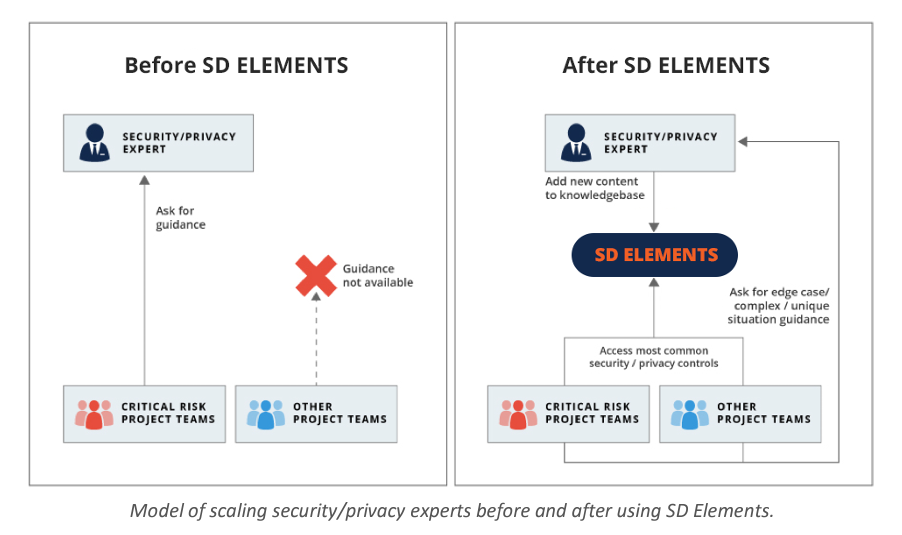
Using SD Elements for General Controls
Practitioners can make use of the following process to set up SD Elements to cover general controls.
Content Subscription
A policy-to-execution platform vendor, such as Security Compass, has a team of researchers that produce content for certain controls, such as secure coding and server hardening. That content grows and is revised on a regular basis. The controls library for the organization encompasses both the subscription content as well as custom organizational content.
Design Control & Define Rules
On top of the out-of-the-box content, security, risk, and privacy/compliance, stakeholders will want to append additional content specific to their organization and context. For example, for GDPR, they may wish to include requirements based on recent rulings about features related to data crossing international borders. They may also need to expand the questionnaire to include additional questions while keeping the length of the questionnaire manageable (see Four Rules of Thumb for Developing Content).
SD Elements makes it easy to define new content that is configured by rules using a guided user interface:
In this process, you can also (and are encouraged to) cross-check internal policies, procedures, guidelines, and baselines to see if there are any privacy-related controls that you should add to the content library.
Every control should also have a corresponding validation process. In a policy-to-execution platform, this could be a “Testing” phase task that is linked to the control via an underlying problem. In more advanced use cases, controls may be automatically verified with a separate tool, such as a configuration review tool, that integrates with the policy-to-execution platform via API.
Start Project & Answer Questionnaire
With the content ready, you can begin to model applications into the SD Elements. In the pilot phase, security or privacy experts often perform this step. In a full deployment, project managers, project owners, or architects from the project teams often take ownership of this step, effectively creating a self-service model.
The process of modeling an application involves creating a new project in SD Elements and answering the questionnaire.
Once completed, SD Elements will produce a prioritized list of controls.
You can further filter the list to focus only on data privacy controls, or you can more holistically review all controls, including security.
For existing systems, a technical lead should go through the resulting list of controls and mark any already implemented controls as “Done.”
Integrate with ALM
After defining the correct set of operational controls, you can add the incomplete controls to the development queue of work. In an agile or DevOps workflow, this means adding it to the product backlog. In a more traditional / waterfall project, this means introducing the controls as requirements into the current or next release.
With SD Elements, you can integrate directly with an Application Lifecycle Management (ALM) tool such as Atlassian’s JIRA and many more.
Learn and Implement Controls
Once pushed into the backlog or requirements list, developers can complete controls one at a time alongside normal feature work. In cases where they cannot complete control, the developers can leave a comment either in their ALM or within SD Elements directly explaining why.
Verify Controls & Integrate with Scanners
The final step in the process is to verify whether controls are completed accurately. For a certain subset of controls, this may be accomplished by integrating results from a scanner. For others, this will require manual testing steps completed by a developer, tester, or security/privacy SME. Alternatively, development teams may be able to set up automated testing scripts to verify controls.
Review Reports
To provide audit evidence for the future, the project manager and security, risk, and compliance stakeholders can produce reports to show the status of a project.
Using SD Elements for Contextual Controls
SD Elements also allows users to incorporate contextual controls, a process that differs slightly from general controls. Here, we will review how to translate the key parts of a Privacy Impact Assessment template into such a platform.
Set up appropriate permissions
To facilitate activities, central privacy or security experts should have access to all projects.
Identify and eliminate redundant questions
A typical PIA asks a series of questions about the project or system in scope, many of which are already in SD Elements out-of-the-box. For example:
● Application name ● Business unit (if applicable) ● Architecture type (e.g. web application)
Keep the Don’t Repeat Yourself (DRY) principle in mind.
Turn open-ended questions into closed multiple choice questions
Many of the remaining questions of a typical PIA are open-ended in nature. For example, some PIA templates ask questions like, “List each data type being collected.” Broad questions like these are onerous to answer and slow down the development process considerably. Instead, use a pre-populated list and a single “Other” option if you want people to specify a different option.
You can then create a control that asks users to specify what the text means, which only shows up in a project when they select the “Other” option:
Create controls on the right way to do something
Instead of asking a question like “Describe your privacy policy,” create controls that specify the minimum standards of a privacy policy for your organization.
Use the flexible rules-based engine to create derivative controls for unique circumstances. For example, the privacy policy of a website based in Europe may differ from one in the United States.
The control should also have a “Testing” phase control that testing teams can use to validate that a control has been met.
Identify points of escalation and add notification triggers
There may be certain circumstances where manual intervention in the process is warranted. For example, if the system stores, processes, or transmits sensitive information such as health data. In this case, you can create a control similar to the above and add an email trigger to a specific user, such as a privacy expert, for when that control shows up. This also serves as a useful way to determine which projects your security and privacy experts should perform a deeper dive into.
Add context specific tasks directly into the project
Subject matter experts who review a project in SD Elements may identify specific, contextual controls for that project that are not already in the system.
With SD Elements, organizations can meet GDPR compliance without sacrificing efficiency and can do so in an auditable framework that proves compliance and provides accountability.
APPENDIX: RULES OF THUMB FOR CONTENT DEVELOPMENT
- Minimize impact: Do not impose a control unless it is necessary. For example, do not ask a development team to implement privacy controls if they are not collecting, storing, or processing personally identifiable information.
- Don’t repeat yourself: Developers should not be answering the same questions multiple times for different stakeholders. Ask them to answer once and use the same data in multiple places. It is also important to keep the size of the initial questionnaire in mind; if it takes longer than 15 minutes to complete the questionnaire, you may start to get feedback.
- Use priorities: Providing a new project with 100 new controls is likely to be met with extensive pushback. Use prioritization so that development teams can implement the controls and prioritize them alongside other features.
- Controls over open-ended questions: Provide controls about what somebody should do, rather than asking an open-ended question that requires an expert to interpret. Allow developers to specify why they can’t implement a control and the reason why. Use “Describe” questions sparingly.
- Testability: Controls should be easily testable. For example, “Validate a consent form for cookies appears upon session initiation.”
- Make changes easy: Do not make people answer an entire assessment for each change. Instead, determine which questions and controls are likely to require reaffirmation and ask them instead. Strive to make the process last minutes instead of hours.








